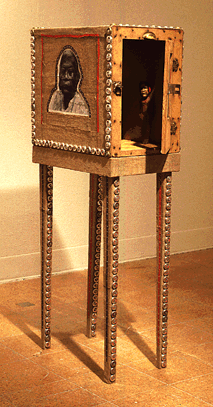
Dead and buried for centuries in the world of "official" art, the florid, emotional art of the baroque is alive and well here in Baja Arizona. It survives in the elaborately ornamented South Tucson shrines, where countless colorful Virgins of Guadalupe are decked out in glittering lights and tinsel. It lives on in household altars filled with ribbons and lace and family photos and artificial flowers in soda-pop bottles. It continues unabated in Day of the Dead shrines, festooned with toys and candy and coffee cans, and in brightly painted tombstones and roadside memorials.
The rich components of the folk baroque have also made a minor foray into the high-art world via works by Latino/a artists, as this year's show of contemporary Hispanic art at the University of Arizona Museum of Art demonstrates. Impacto Cultural IV: Hispanic Sculptors in Arizona is filled to the brim with three-dimensional works that draw on the aesthetic of the household shrines, whose thrifty folk creators see all materials as potential art objects. The museum show has dolls emblazoned with buttons and nailed to crosses (made by Phillip Estrada), birthday-present wrapping paper and masking tape twisted into snarling figures (Michael Cajero), simpering dime-store porcelain angels lined up on shelves (Lawrence M. Yáñez), a luridly painted rocking chair hitched up to a plough (Alfred J. Quiroz).
In fact, out of the eight artists showing, only two, Julia Arriola and David Aguirre, are working in conventional sculptural materials, Arriola in copper, Aguirre in clay. But then you hardly notice Arriola's classical bent, since her work is a series of five pieces of lingerie: elegant metallic bras, a teddy and a corset. Also featured in last year's edition of Impacto Cultural, subtitled "Women Across the Border," Tucson artist Arriola has been working this underwear vein for some time, giving constricting undies a feminist critique. The familiar Aguirre, who runs Art Forms Gallery downtown, exhibits a collection of his fantastic hybrid figures, part human, part animal. His works in sensuous colored clay are like folktales come to life.
 But the other six artists in the show delight in exuberant mixed-media
creations. Cajero, one of the best known of the group, exhibited
a room-size Light Altars exhibition at the museum almost three
years ago. Timed to coincide with the Quincentenary of Columbus's
arrival in the New World, Cajero's savage paper and masking tape
works attacked the brutality of the Conquest and the cultural
imperialism of the Spanish conquerors.
But the other six artists in the show delight in exuberant mixed-media
creations. Cajero, one of the best known of the group, exhibited
a room-size Light Altars exhibition at the museum almost three
years ago. Timed to coincide with the Quincentenary of Columbus's
arrival in the New World, Cajero's savage paper and masking tape
works attacked the brutality of the Conquest and the cultural
imperialism of the Spanish conquerors.
This time around Cajero delves into conventional icons of Old Spain--a flamenco dancer, a guitarist and a military guy--with only slightly less savagery. His "Guardia Civil," a four-foot-high pedestal sculpture in shiny papier maché, is a wild, twisting figure on a wild, twisting horse. The paramilitary guardias were known to generations of Spaniards by their peculiar horned black hats and their ruthlessness in propping up Franco's Fascist regime. Cajero's fantastic version of an evil guardia, made of fragile papers destined to wither away in time, lunges menacingly toward a hapless civilian, the flamenco dancer writhing pitifully at his side.
Other artists borrow not just the materials but the structure of the shrines. Alex Garza, a Tucsonan who curated the show, offers up "Lola's Cage," a sad little altar to a restricted life. It features a wooden box covered in burlap, emblazoned with photographs on cloth of an old Hispanic woman's face. The box is fashioned into a jail cell, with barred windows and door. Inside, on the floor, is the barrio's trademark linoleum. The walls bear pictures of saints. Lola is inside too, in the form of a little mummy figure with a photo of her puzzled face glued to the head. If she sees her little box shrine as a haven, Garza suggests it's a prison barred up by religion and sex roles.
Estrada's strange pieces offer a sort of social commentary too, but it's more oblique. A Bisbee artist who recently moved to Tucson, Estrada this week opened a one-person show at José Galvez Gallery. Besides his weird crucified baby dolls in the museum show, Estrada has created "Sombrero Tree Party," an outrageous painted assemblage of tree branches, transparent colored Easter grass, dolls, hats and car parts. One doll's wearing hubcaps and playing a horn; the other's dolled up in a big Mexican sombrero. What, exactly, it's all about is hard to say. One thing you can say is that this wild, disrespectful, joyous ode to junk cranks up the baroque impulse, chugs it into rococo and careens on into the surreal.
Impacto Cultural IV: Hispanic Sculptors in Arizona continues through May 31 at the University of Arizona Museum of Art. New summer hours are 10 a.m. to 3 p.m. Monday through Friday, noon to 4 p.m. Sunday. Admission is free. For more information call 621-7567. James S. Griffith's Southern Arizona Folk Arts was published by the University of Arizona Press in 1988.
Photo Captions:
"Lola's Cage," 1995, by Alex Garza.
"Bird and Monkey," 1995, by David Aguirre.





